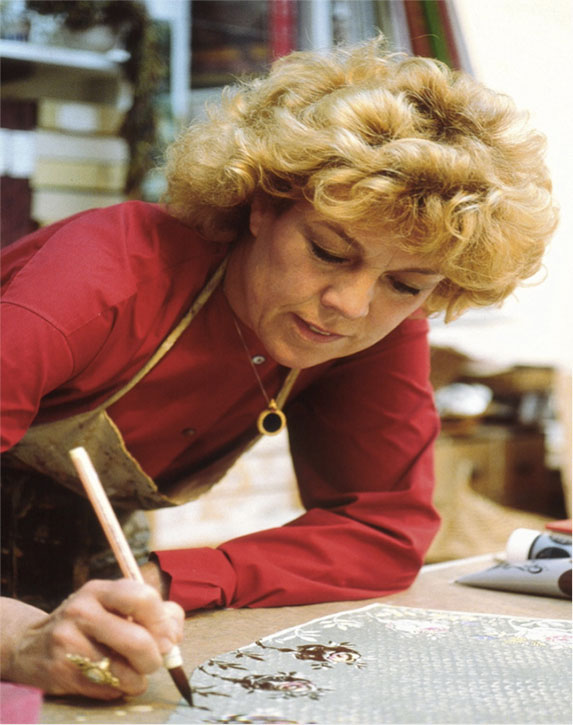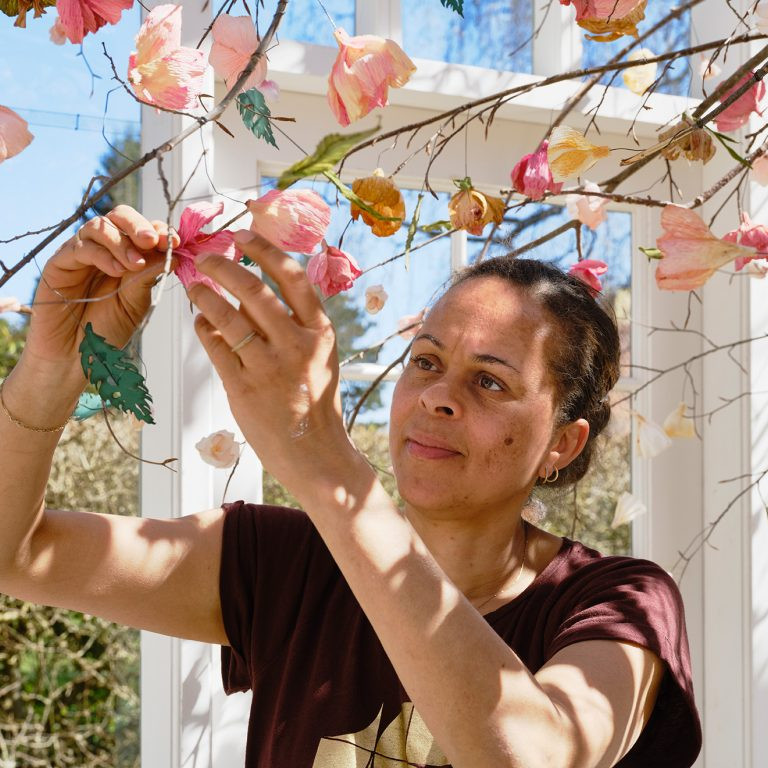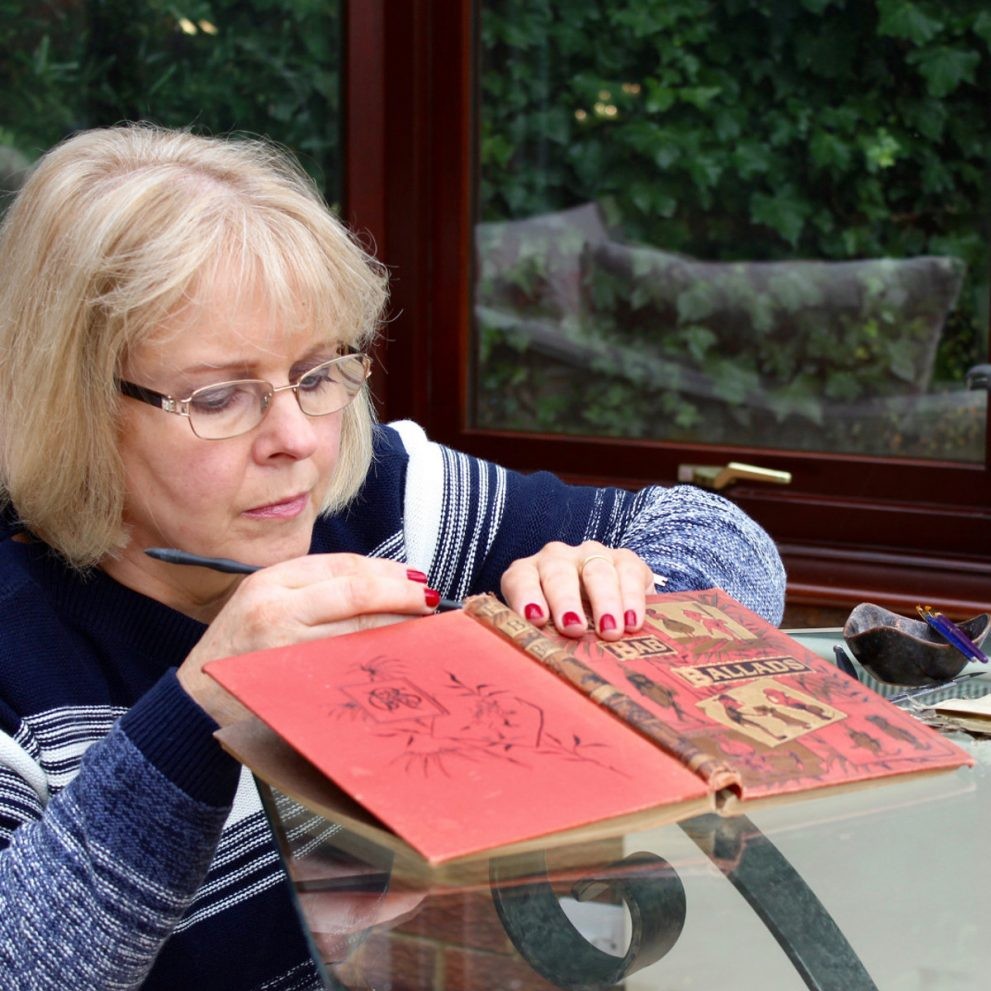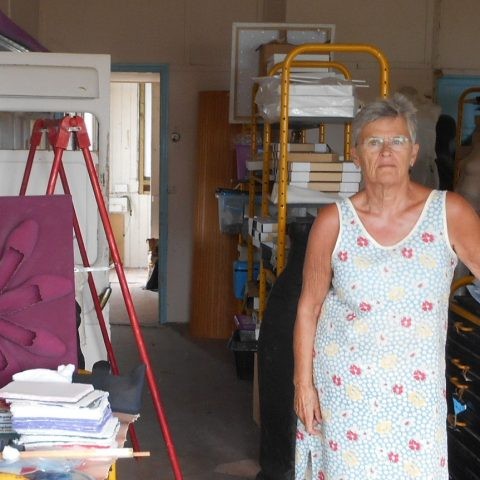Isabelle de Borchgrave Paper Costumes Artist - Brussels, Belgium
Your work is all done with paper.
Can you explain the size and type of paper you use?
The paper I use is the common pattern paper that the stylists use in their atelier. I just don’t buy sheets of paper but huge rolls because I need a lot of paper to make a dress, several meters. This paper is really amazing because it is very malleable and resists very well to the paint I use. The width of the paper is always the same as I use the same roll for all the dresses: 150 cm. The length will depend on what I am going to do.
Each costume takes many processes to get to completion.
Can you explain briefly the process you use?
The first step, and one of the most important parts of the work, is research. I have to be very careful not to make a mistake … I have to study the period of the costume, the history of the character if it is a portrait, … Research can take weeks. After the choice of the model of the dress, one of the stylists working in my atelier creates a white pattern that will be fixed on a mannequin to see how to recreate the dress. When the white patterns suits, we paint the background on to the huge pieces of paper. When it is finished I paint the details, the trompe l’oeil, … Sometimes we rumple the paper to give it some volume. When the paper is prepared, we cut it and we put together all the pieces on the mannequin. At this time we begin to create all the accessories and details: wigs, laces, collars, bags, jewels, shoes, gloves,
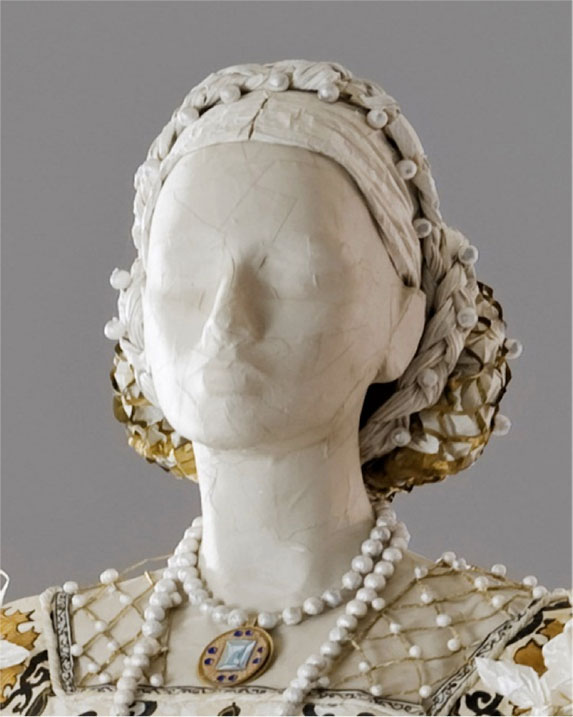
Elenonore de Tolede by Isabelle de Borchgrave. Photo: Andreas von Einsiedel
Your work is taken from very famous paintings in galleries. Do you take photographs or make drawings in galleries?
I visit a lot of museums and galleries when I am travelling but I do not usually have the time to sit in front of a painting and draw it. I have a lot of books (more than 3500!) and catalogues of the exhibitions I loved … When I am doing my research I remember what I saw. Museums also give me very good reproductions of the paintings they want me to recreate if I do not have enough information in my books. I never do exactly the same dress as the one on the image. I have, it is an interpretation with other dresses of the same period. On a painting you never see the full dress: if you have the front you do not have the back … So I have to recreate a lot.
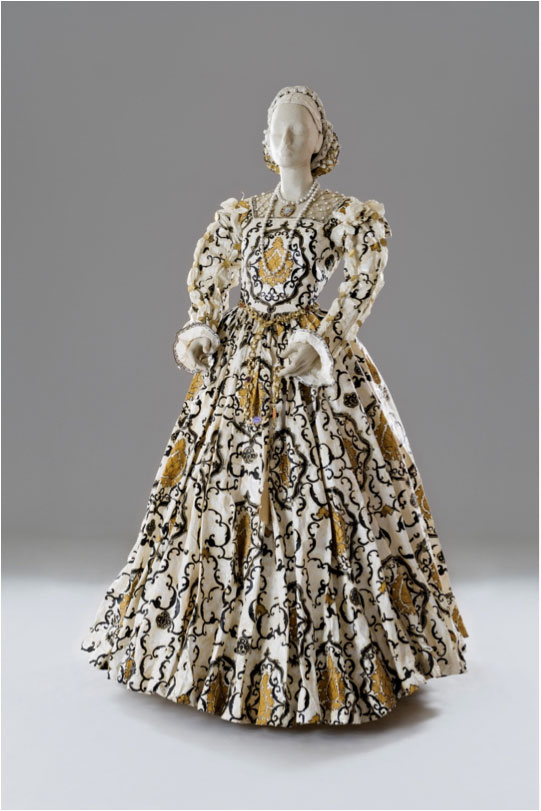
Elenonore de Tolede by Isabelle de Borchgrave. Photo: Andreas von Einsiedel
Often in the painting we only have one view. Your work takes from the 2D painting to 3Dsculptured form. Explain how you fill in the missing elements?
This is a really exciting part of the creation. It is part of imagination, Fashion History and History. With my stylists we do a lot of tests, we try different things we imagine how it had to be at the period when the dress was worn. Sometimes it is easy, sometimes it isn’t. A lot of research in fashion books has to be done for that part of the creation. We sometimes ask the help or just the confirmation of museums to be sure we are not making mistakes.
What painting did you base her from?
This costume is inspired by a portrait painted by Bronzino in 1545 : Eleonora of Toledo with her son Giovanni de’ Medici; Oil on wood.
Where is the painting?
In Florence (Italy), in the Uffizi Galleries
What access did you have to this work?
I visited the Uffizi several times, and I have a lot of different books representing the portrait.
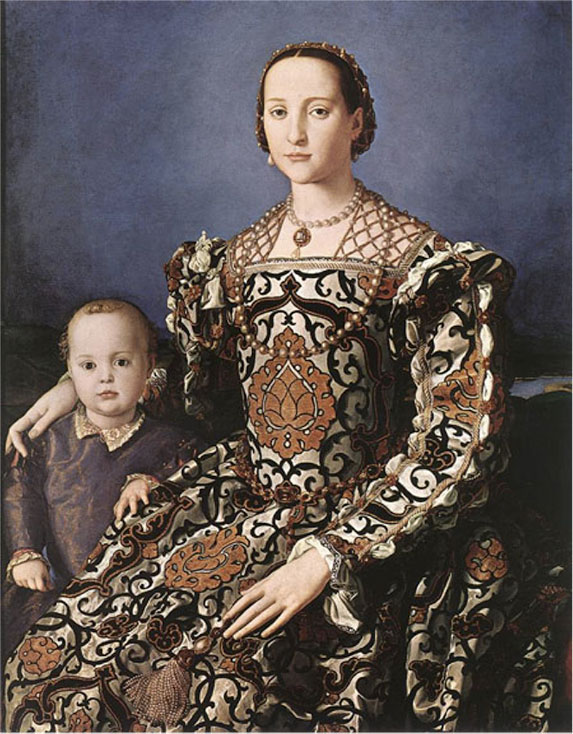
Eleonora of Toledo with her son Giovanni de’ Medici Bronzino in 1545, Wikipedia.
Please describe the fabric of her dress and the pattern?
The real dress of Eleonore de Tolède doesn’t exist anymore. The only thing remaining is a little piece of fabric with the black and gold stencil that you can see on the dress that I recreated. We had to work with only with the painting. I had to be very careful to respect as much as possible the design of the stencil that I recreate in my studio because that was the only thing remaining, “a kind of homage”.
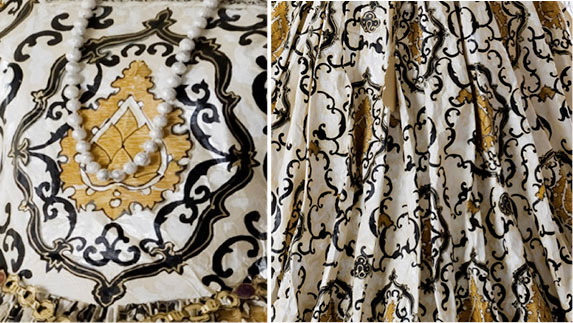
Eleonore de Tolede by Isabelle de Borchgrave. Photo: Andreas von Einsiedel
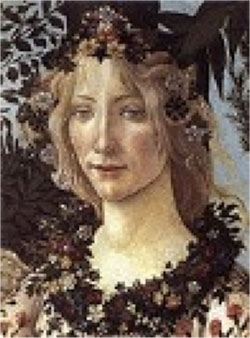
“ Primavera, Flore – 1482, Spring of Sandro Botticelli , known as Allegory of Spring, Wikipedia.
This is a very different costume as the fabric is light and sheer. How do you manage to get the transparency?
For that dress there are two different papers used. One is the normal one, and the other is a transparent one very difficult to use because it is very fragile. So when I paint on it, I have to be very careful not to tear or damage it.
How do you make the decision on details like the hair on Flore which is neutral?
As I said, a good part of my work is imagination. It is an interpretation. If I feel it like this I will do it like this. Those dresses are not only fashion or history, they are pieces of art. Those dresses are not mannequins, they are paper sculptures.
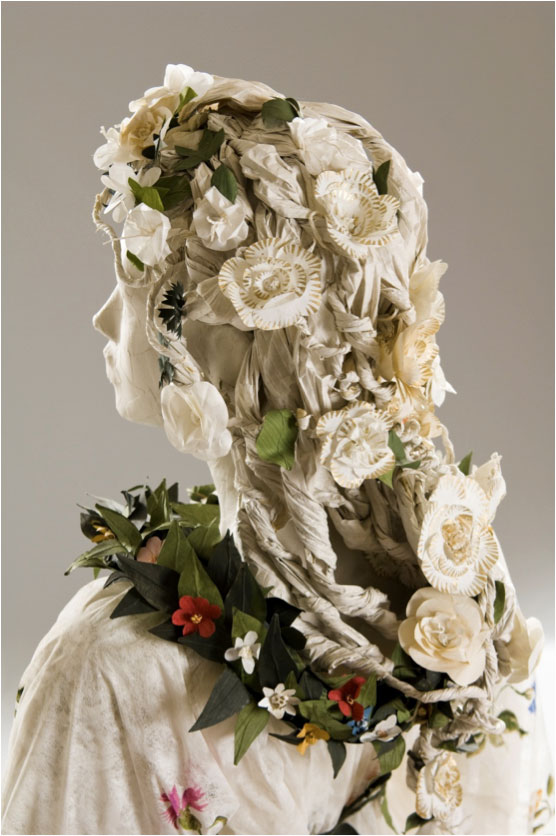
Primavera by Isabelle de Borchgrave. Photo: Andreas von Einsiedel.
Explain the importance of details like the flowers in the hair and around the shoulders of Flore?
This character represents the allegory of Spring … It was important that nature was all around her. She needed to represent nature, spring, life, … That is why the flowers make a great part of her costume. Flowers and transparency, because the transparency represents the lightness of the season.
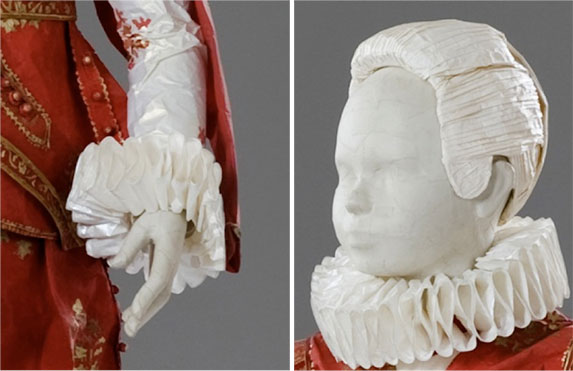
Medicis Trio – Enfants by Isabelle de Borchgrave. Photo: Andreas von Einsiedel.
The Medici work, was it the first time you had to work with large neck ruffles?
No, I had to do neck ruffles for the Papiers à la Mode collection, for the dress of Elizabeth I for example. With the Medici collection it was the first time we did ones with so many details, so sophisticated, so precious.
Where are all of the Medici pieces?
Some of them were exhibited in the Palais d’Egmont in Brussels for the National Day the 21st of July. That part of the collection is now in my atelier, and the rest is in boxes waiting for their next exhibition, which is not decided yet.
You have children as well as adults in your collections.Can you describe the work on ‘Les Filles de Charles Emmanuel III’ 1730?
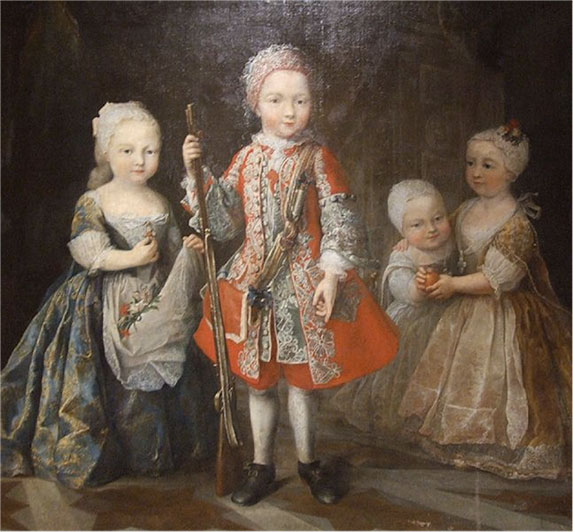
Charles Emmanuel III’s Children 1730. Maaria Ciovanna Clementi 1690-1761.
Photo Odejea Chambery Museum.
The children are 123 cms high. How do you decide on the scale of your work?
They are 123 cms! Which is a normal children size for their age … For The Medici collection we did something quite different from the other paper dresses collections : all the mannequins are higher than the normal human size. Everything is bigger, it is to accentuate the majesty of the characters.
The detail on all costumes must determine the base model. Can you discuss the way you decide on the model you use for each collection?
The model is usually chosen with the museum if it is an order. The museum asks me for a particular dress which is based on a painting or fabrics from the museums personal collections.
The paper dresses collections I created with my team (Papiers à la Mode, I Medici, Forrtuny, Ballets Russes) are different. I chose to reproduce what I liked, it is more personal. Of course it has to be appropriate with the subject: for the Medici collection for example all the dresses are ceremonial dresses.
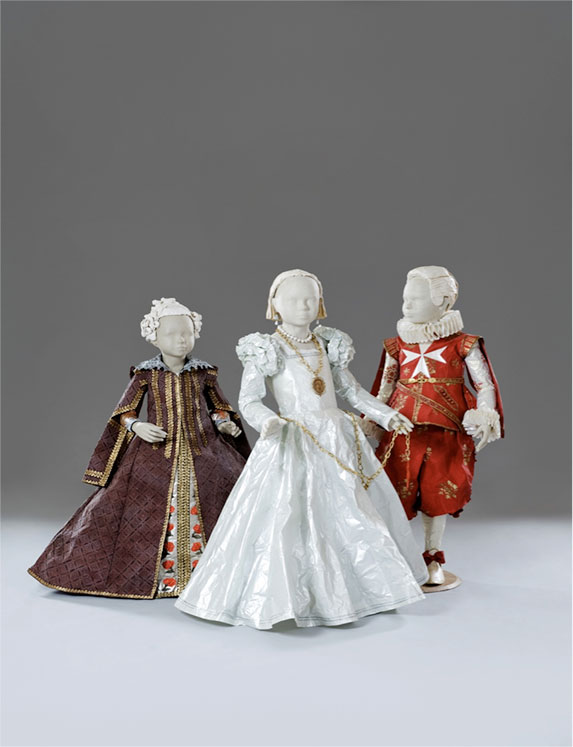
Enfants de Charles Emmanuel III by Isabelle de Borchgrave.
Photo: Andreas von Einsiedel.
Not only do you work on the actual clothes, you have the details of wigs, handkerchiefs, jewellery and shoes.
Can you discuss the importance of these extra details?
All those details make a big part of the costume. They make it alive. It helps to recreate the context where the costume was worn. It is very important. It can also help to add a little fantasy to the costume, or it just helps to make the costume more realistic.
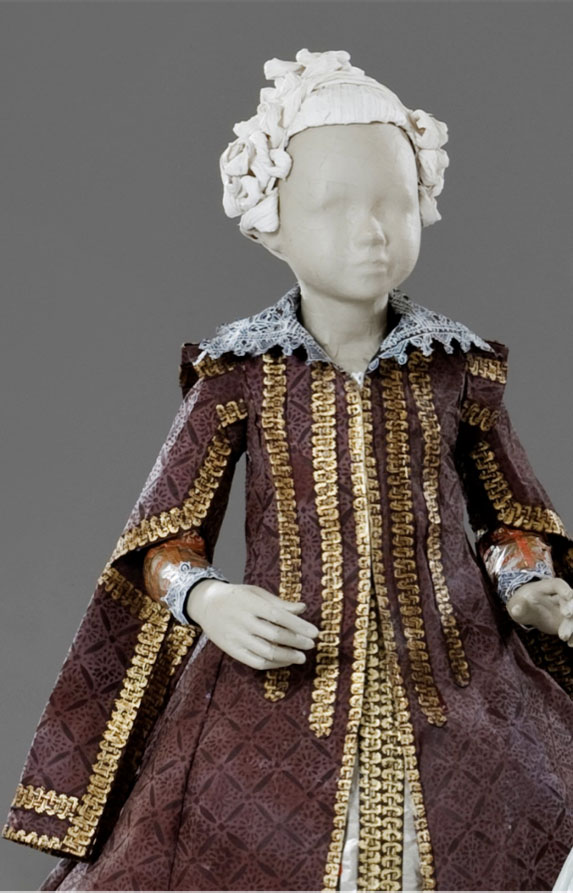
Enfants de Charles Emmanuel III by Isabelle de Borchgrave.
Photo: Andreas von Einsiedel.
One of the more modern pieces I would like you to share with us is Jackie Kennedy’s wedding dress.
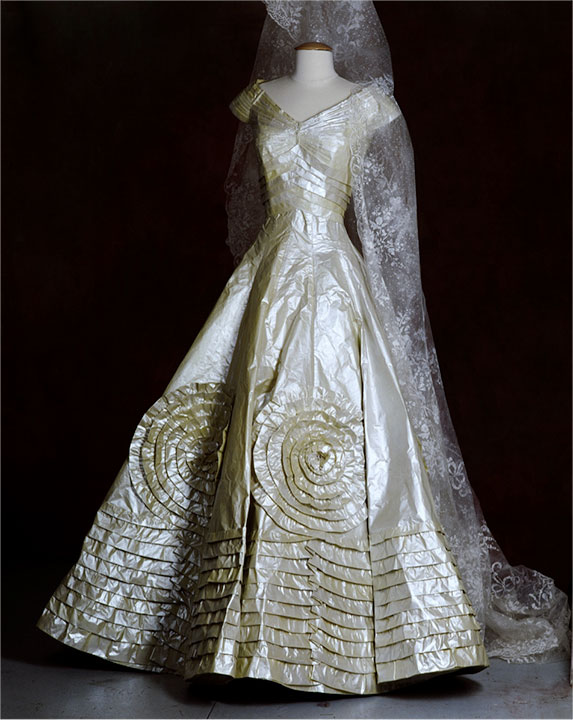
Paper Art of Jackie Kennedy’s Wedding dress, by Isabelle de Borchgrave.
Photo: Ghislain David de Lossey
How did you get this commission?
There was a big exhibition in Chicago on Jackie Kennedy’s dresses. An American, Jamie Becker (who worked at that time for Marshal Fields) had the idea to ask me to create this wedding dress in paper.
Where is it on permanent display?
It is exhibited in the Kennedy Memorial in Boston since 2004.
Who was the original designer of the dress?
The designer was Ann Lowe.
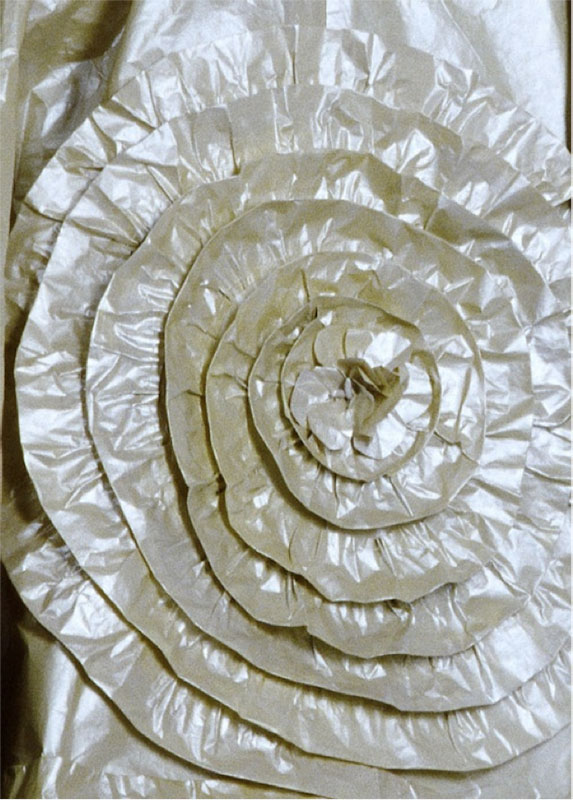
Paper Art of Jackie Kennedy’s Wedding dress, by Isabelle de Borchgrave.
Photo: Ghislain David de Lossey
Is there a copywriter problem when you are working with current costumes?
There could be a copywriter problem; that is why I always ask for authorization for this kind of dress. Caroline Kennedy gave it to me at that time.
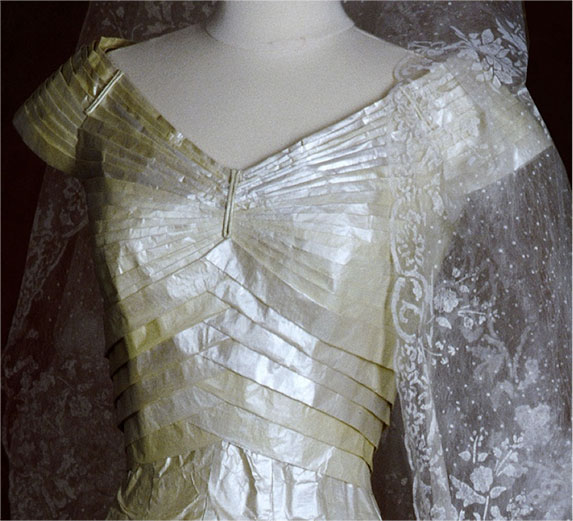
Paper Art of Jackie Kennedy’s Wedding dress, by Isabelle de Borchgrave.
Photo: Ghislain David de Lossey
Tell us about the work involved in Jackie Kennedy’s veil?
The veil is also in paper. It is created from a drawing of the veil of the Bouvier family that Jackie Kennedy wore during her wedding. It is made in “papier non-tissé” and it is very fragile. All the designs are stencils that I recreated for the veil.
You also work on fashion shoots; explain how much freedom you have with this type of work?
I do not really work on fashion shoots. I did three fashion shows for a social organization called “Les Petits Riens”. I really liked it and all the artists doing it at the same time could do what they wanted. It was really interesting. I once did the background of a Dior Fashion show (huge paper flowers). Arte International also asked me to create five dresses with their mural paper and they photographed them on real mannequins. It was a great experience but it is not something I am looking for. My dresses are art sculptures before being fashion.
Your designs are also worn on special occasions.
Tell about your Royal commission.
Our Queen, Fabiola asked me to create something in paper for her to wear for the wedding of one of her nephew in Spain. I did a jacket and a hat, and I also painted a fan. The funny thing is that it was raining that day! A bodyguard had to carry an umbrella for the Queen the whole day and followed her everywhere.
In September you are opening up your studio. Explain how this is going to work?
From September 2012, I will be opening my studio to visitors.
On the first and third Monday of the month, visitors will be shown around the premises for an hour and a half and learn about my life and career. They will also have the opportunity to admire the works as they are being created in the studio.
Films about the different collections of paper costumes will be screened, giving an insight into the work being carried out by Isabelle and her team.
A complimentary drink will be served to round off the tour. At this point, visitors can also look around the shop adjoining the gallery.
Visits will only be in French.

Where can we currently see your work?
Prêt-à-Papier
The Exquisite Art of Isabelle de Borchgrave”
Hillwood Estate,
Museum and Gardens
Washington, USA
16/06/2012 to 30/12/2012
Le Singe de la Mode
Neues Palais
Potsdam, Germany
28/04/2012 to 28/10/2012
Website: http://www.isabelledeborchgrave.com/
Isabelle de Borchgrave, Brussels, Belgium,
Interview by Deborah Blakeley, September, 2012
Think a colleague or friend could benefit from this interview?
Knowledge is one of the biggest assets in any business. So why not forward this on to your friends and colleagues so they too can start taking advantage of the insightful information the artist has given?
Other artists you may be interested in:


